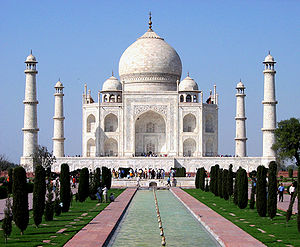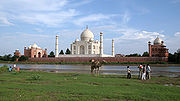
The mausoleum of the Taj Mahal
The Taj Mahal (pronounced /tɑdʒ məˈhɑl/; Hindi: ताज महल; Persian/Urdu: تاج محل) is a mausoleum located in Agra, India, built by Mughal Emperor Shah Jahan in memory of his favorite wife, Mumtaz Mahal.
The Taj Mahal (also "the Taj") is considered the finest example of Mughal architecture, a style that combines elements from Persian, Indian, and Islamic architectural styles.[1][2] In 1983, the Taj Mahal became a UNESCO World Heritage Site and was cited as "the jewel of Muslim art in India and one of the universally admired masterpieces of the world's heritage."
While the white domed marble
mausoleum is its most familiar component, the Taj Mahal is actually an
integrated complex of structures. Building began around 1632 and was
completed around 1653, and employed thousands of artisans and craftsmen.[3]
The construction of the Taj Mahal was entrusted to a board of
architects under imperial supervision including Abd ul-Karim Ma'mur
Khan, Makramat Khan, and Ustad Ahmad Lahauri.[4][5] Lahauri is generally considered to be the principal designer.[6]
Origin and inspiration
In 1631, Shah Jahan, emperor during the Mughal empire's
period of greatest prosperity, was griefstricken when his third wife,
Mumtaz Mahal, died during the birth of their fourteenth child, Gauhara Begum.[7] Construction of the Taj Mahal began in 1632, one year after her death.[8] The court chronicles of Shah Jahan's grief illustrate the love story traditionally held as an inspiration for Taj Mahal.[9][10] The principal mausoleum was completed in 1648 and the surrounding buildings and garden were finished five years later. Emperor Shah Jahan himself described the Taj in these words:[11]
Should guilty seek asylum here,
Like one pardoned, he becomes free from sin.
Should a sinner make his way to this mansion,
All his past sins are to be washed away.
The sight of this mansion creates sorrowing sighs;
And the sun and the moon shed tears from their eyes.
In this world this edifice has been made;
To display thereby the creator's glory.
The Taj Mahal incorporates and expands on design traditions of Persian architecture and earlier Mughal architecture. Specific inspiration came from successful Timurid and Mughal buildings including; the Gur-e Amir (the tomb of Timur, progenitor of the Mughal dynasty, in Samarkand),[12] Humayun's Tomb, Itmad-Ud-Daulah's Tomb (sometimes called the Baby Taj), and Shah Jahan's own Jama Masjid in Delhi. While earlier Mughal buildings were primarily constructed of red sandstone, Shah Jahan promoted the use of white marble inlaid with semi-precious stones, and buildings under his patronage reached new levels of refinement.[13]
Architecture
The tomb
The central focus of the complex is the tomb. This large, white
marble structure stands on a square plinth and consists of a
symmetrical building with an iwan (an arch-shaped doorway) topped by a large dome and finial. Like most Mughal tombs, the basic elements are Persian in origin.

The Taj Mahal seen from the banks of river Yamuna
The base structure is essentially a large, multi-chambered cube with chamfered
corners, forming an unequal octagon that is approximately 55 meters on
each of the four long sides. On each of these sides, a massive pishtaq,
or vaulted archway, frames the iwan with two similarly shaped, arched
balconies stacked on either side. This motif of stacked pishtaqs is
replicated on the chamfered corner areas, making the design completely
symmetrical on all sides of the building. Four minarets frame the tomb, one at each corner of the plinth facing the chamfered corners. The main chamber houses the false sarcophagi of Mumtaz Mahal and Shah Jahan; the actual graves are at a lower level.
The marble dome that surmounts the tomb is the most spectacular
feature. Its height of around 35 meters is about the same as the length
of the base, and is accentuated as it sits on a cylindrical "drum"
which is roughly 7 metres high. Because of its shape, the dome is often
called an onion dome or amrud (guava dome). The top is decorated with a lotus design, which also serves to accentuate its height. The shape of the dome is emphasised by four smaller domed chattris
(kiosks) placed at its corners, which replicate the onion shape of the
main dome. Their columned bases open through the roof of the tomb and
provide light to the interior. Tall decorative spires (guldastas) extend from edges of base walls, and provide visual emphasis to the height of the dome. The lotus motif is repeated on both the chattris and guldastas. The dome and chattris are topped by a gilded finial, which mixes traditional Persian and Hindu decorative elements.
The main finial was originally made of gold but was replaced by a copy made of gilded bronze
in the early 19th century. This feature provides a clear example of
integration of traditional Persian and Hindu decorative elements. The
finial is topped by a moon, a typical Islamic motif whose horns point heavenward.
Because of its placement on the main spire, the horns of the moon and
the finial point combine to create a trident shape, reminiscent of
traditional Hindu symbols of Shiva.[3]
The minarets, which are each more than 40 meters tall, display the
designer's penchant for symmetry. They were designed as working
minarets ó a traditional element of mosques, used by the muezzin
to call the Islamic faithful to prayer. Each minaret is effectively
divided into three equal parts by two working balconies that ring the
tower. At the top of the tower is a final balcony surmounted by a
chattri that mirrors the design of those on the tomb. The chattris all
share the same decorative elements of a lotus design topped by a gilded
finial. The minarets were constructed slightly outside of the plinth so
that, in the event of collapse, (a typical occurrence with many tall
constructions of the period) the material from the towers would tend to
fall away from the tomb.
|
|
|
|
Main iwan and side pishtaqs
|
Simplified diagram of the Taj Mahal floor plan
|
Exterior decoration
The exterior decorations of the Taj Mahal are among the finest to be found in Mughal architecture.[citation needed]
As the surface area changes the decorations are refined proportionally.
The decorative elements were created by applying paint, stucco,
stone inlays, or carvings. In line with the Islamic prohibition against
the use of anthropomorphic forms, the decorative elements can be
grouped into either calligraphy, abstract forms or vegetative motifs.
Throughout the complex, passages from the Qur'an are used as decorative elements. Recent scholarship suggests that the passages were chosen by Amanat Khan. [14][15] The texts refer to themes of judgment and include:
The calligraphy on the Great Gate reads "O Soul, thou art at rest. Return to the Lord at peace with Him, and He at peace with you."[15]
The calligraphy was created by the Persian calligrapher Abd ul-Haq, who came to India from Shiraz, Iran, in 1609. Shah Jahan conferred the title of "Amanat Khan" upon him as a reward for his "dazzling virtuosity".[5]
Near the lines from the Qur'an at the base of the interior dome is the
inscription, "Written by the insignificant being, Amanat Khan Shirazi."[16] Much of the calligraphy is composed of florid thuluth script, made of jasper or black marble,[5]
inlaid in white marble panels. Higher panels are written in slightly
larger script to reduce the skewing effect when viewed from below. The
calligraphy found on the marble cenotaphs in the tomb is particularly detailed and delicate.
Abstract forms are used throughout, especially in the plinth,
minarets, gateway, mosque, jawab and, to a lesser extent, on the
surfaces of the tomb. The domes and vaults of the sandstone buildings
are worked with tracery of incised painting to create elaborate geometric forms. Herringbone
inlays define the space between many of the adjoining elements. White
inlays are used in sandstone buildings, and dark or black inlays on the
white marbles. Mortared areas of the marble buildings have been stained
or painted in a contrasting colour, creating geometric patterns of
considerable complexity. Floors and walkways use contrasting tiles or blocks in tessellation patterns.
On the lower walls of the tomb there are white marble dados that have been sculpted with realistic bas relief
depictions of flowers and vines. The marble has been polished to
emphasise the exquisite detailing of the carvings and the dado frames
and archway spandrels have been decorated with pietra dura
inlays of highly stylised, almost geometric vines, flowers and fruits.
The inlay stones are of yellow marble, jasper and jade, polished and
leveled to the surface of the walls.
|
|
|
|
|
Reflective tiles normal exposure
|
Reflective tiles under exposed
|